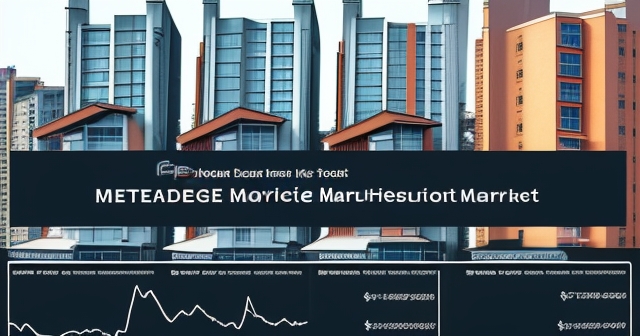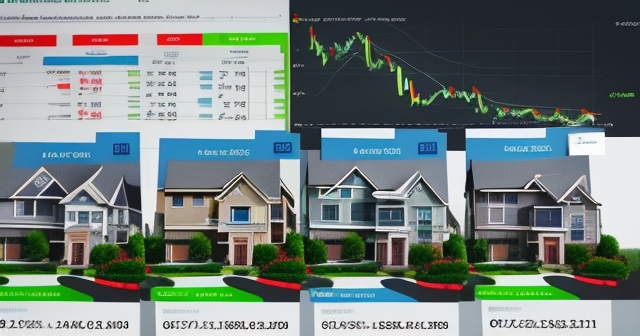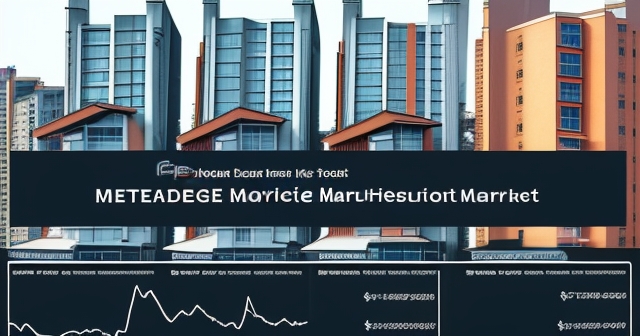Understanding MBA Mortgage Applications: A Deep Dive for Traders
Welcome! We’re embarking on a journey to understand one of the key indicators in the U.S. housing market: the Mortgage Bankers Association (MBA) Weekly Mortgage Applications Survey. This data release might seem focused purely on real estate, but as you’ll discover, it holds significant clues for traders and investors across various markets, including foreign exchange.
Why should you, as a trader or investor, pay attention to weekly mortgage application numbers? Because housing is a cornerstone of the U economy. It impacts consumer confidence, spending, and the financial sector. Changes in mortgage activity can signal shifts in economic momentum and influence broader market sentiment, which in turn affects asset prices.
Think of the housing market as a massive engine driving economic activity. When people are buying homes, they’re also buying furniture, appliances, and services, stimulating growth. Mortgage applications are an early signal of this activity. By understanding this data, you gain a crucial piece of the economic puzzle.
Our goal is to break down this complex dataset, explore recent trends using specific examples, and show you how you can integrate this knowledge into your trading strategy. Let’s start by understanding what the MBA survey actually measures.

What is the MBA Weekly Mortgage Applications Survey?
The Mortgage Bankers Association (MBA) conducts a weekly survey that serves as a timely pulse check on U.S. mortgage activity. Every week, the MBA collects data from a significant portion of the residential mortgage market. This isn’t just a small sample; the survey covers mortgage applications from over 75% of all U.S. retail residential mortgage originators, including mortgage bankers, commercial banks, and savings & loan associations.
This broad coverage makes the survey highly representative of what’s happening in the market right now. It’s typically released every Wednesday morning and provides data for the week ending the previous Friday. This speed is crucial; it gives us insights far faster than many other housing or economic indicators.
The survey reports several key figures:
- Market Composite Index: This is the headline number, representing the total volume of mortgage applications received by lenders, adjusted for seasonality.
- Purchase Index: This index specifically tracks applications for mortgages to purchase a home. This is often considered a key indicator of forward-looking housing demand.
- Refinance Index: This index tracks applications from homeowners looking to refinance their existing mortgages. This number is highly sensitive to changes in mortgage rates.
- Average Contract Interest Rates: The survey also reports average interest rates for various loan types (e.g., 30-year fixed-rate, 15-year fixed-rate, FHA loans). These rates are critical context for interpreting the application numbers.
- Share Data: It provides the percentage of applications for refinance activity versus purchase activity, and the share of activity for different loan types (Conventional, FHA, VA, USDA).
Why is this data so valuable? Because it’s a leading indicator. Unlike data on housing starts or existing home sales, which capture activity already underway or completed, mortgage applications tell us about demand at the very beginning of the home-buying or refinancing process. A surge or decline in applications suggests potential future activity in the housing market.
Understanding these components helps you get a clearer picture. Are people buying more homes (Purchase Index up)? Are homeowners taking advantage of lower rates (Refinance Index up)? Or is activity stalling across the board?
Breaking Down Recent Trends: April 2025 vs. June 2024
Now, let’s look at some specific data points to see how volatile this market can be and what influences those swings. We have data from two distinct periods that highlight different market dynamics: late April 2025 and early June 2024.
Consider the week ending April 25, 2025. The overall MBA Market Composite Index, on a seasonally adjusted basis, showed a decrease of 4.2% week-over-week (WoW). This tells us that, after accounting for typical seasonal patterns (like the spring homebuying season), the pace of mortgage applications slowed down compared to the previous week.
Focusing on the Purchase Index, which is particularly important for gauging demand for new homes, we saw a similar picture. The seasonally adjusted Purchase Index dropped by 4% WoW. Even looking at the unadjusted numbers, the Purchase Index was down 3% WoW. This represented the slowest pace of purchase applications since February of that year.
This late April 2025 data suggests a softening in buyer demand. Why might this be happening? The MBA’s commentary often points to factors like broader economic uncertainty and signs of labor market weakness during this period. When people feel less secure about their jobs or the economy’s direction, they tend to hesitate on major commitments like buying a house, even if mortgage rates are stable.
Speaking of rates, the average 30-year fixed mortgage rate was reported to be near 6.89% during that week. While not drastically higher than previous weeks, these elevated rates compared to historical averages continued to present affordability challenges for many potential buyers, contributing to the subdued activity.

The Contrast: A Rate-Driven Surge in June 2024
Now, let’s jump back a bit to the week ending June 7, 2024. The picture here is dramatically different. In that week, the overall MBA Market Composite Index surged by a significant 15.6% WoW! This wasn’t just a small bounce; it was described as the sharpest increase since January 2023. Think about that – the biggest jump in almost a year and a half.
What happened to purchase applications during this surge? The Purchase Index rose a robust 12% WoW. Refinance applications saw an even larger leap, soaring 28% WoW. This period shows the sheer power of interest rate movements on mortgage activity.
The catalyst for this surge? A modest drop in average mortgage rates. In the week ending June 7, 2024, average rates reportedly declined by around 5 basis points (bps). Simultaneously, benchmark Treasury yields, which influence mortgage rates, were also falling. This relatively small movement in rates was enough to unleash significant pent-up demand, particularly for refinancing, but also for purchases.
Comparing these two periods (April 2025 weakness vs. June 2024 surge) is instructive. It highlights the high sensitivity of the mortgage market to both economic sentiment and, perhaps even more directly, to small changes in borrowing costs. The June 2024 data is a strong reminder that even minor rate dips can open the door for many potential buyers and refi candidates who were previously on the fence.

Drilling Deeper: YoY Trends and Loan Type Performance
While week-over-week changes grab headlines, looking at the year-over-year (YoY) figures provides essential context. Even though purchase applications weakened week-over-week in late April 2025, the unadjusted Purchase Index was actually 3% higher year-over-year for that same week. What does this tell us?
It suggests that despite the recent dip, the underlying trend for home-buying activity was still slightly above where it was one year prior. This could be due to various factors, such as modest improvements in housing inventory compared to the extremely tight conditions in the past, or perhaps changing demographics slowly pushing new buyers into the market despite affordability challenges.
Looking at different loan types within the purchase category also reveals nuances. In the week ending April 25, 2025, conventional purchase applications saw a notable decline of 6%. VA (Veterans Affairs) applications also decreased by 4%. However, FHA (Federal Housing Administration) purchase applications experienced only a slight decline.
Why the difference? FHA loans often cater to first-time homebuyers or those with lower credit scores and smaller down payments. Their relative resilience compared to conventional loans might suggest that this segment of the market, perhaps driven by necessity or specific programs, was slightly less impacted by the factors causing the broader decline, or that affordability constraints are particularly hitting the conventional market harder.
Understanding these segment-specific trends helps you build a more complete picture of who is participating in the housing market and which parts are showing relative strength or weakness.
| Loan Type | Change in Applications (April 2025) |
|---|---|
| Conventional | -6% |
| VA | -4% |
| FHA | -1% |
Refinance Activity: A Leading Indicator of Rate Sensitivity
Refinance activity is often described as being even more sensitive to mortgage rate changes than purchase activity. Why? Because homeowners typically refinance to secure a lower interest rate or change loan terms (like switching from an adjustable-rate to a fixed-rate). A drop of even a quarter or half a percentage point can make refinancing financially attractive for a large pool of existing homeowners.
In the week ending April 25, 2025, while purchase activity dipped, refinance applications also dipped by 4% WoW. However, it’s interesting to note that refinance applications were a substantial 42% higher year-over-year for that week. This suggests that over the course of a year, there had been overall improvements in conditions (perhaps slight rate dips or more awareness of options) that encouraged more refinancing activity compared to the previous year, even though the week-over-week trend was negative.
The share of refinance activity relative to total applications remained relatively stable at 37.3% in late April 2025. However, look at the June 2024 data again: refinance applications soared 28% WoW. This dramatic jump underscores just how quickly refinance demand can react to falling rates. When rates drop, the incentive to refinance for existing homeowners becomes much stronger, and they often act quickly.
This makes the Refinance Index a sort of canary in the coal mine for rate movements. A sharp increase in refinancing often happens when rates become more favorable, and this can sometimes precede or coincide with an increase in purchase activity as well, provided affordability allows.
The average loan size for refinances also offers clues. In the week ending April 25, 2025, the average refinance loan size declined to a three-month low of just under $290,000. This could indicate that smaller mortgages or less expensive homes are being refinanced, or that homeowners are choosing “cash-out” refinances less frequently, potentially due to less equity or economic caution.

Connecting the Dots: Rates, Economy, and Applications
It’s clear that mortgage application data is influenced by a confluence of factors, but mortgage rates and broader economic conditions are arguably the most significant drivers.
Mortgage Rates: This is perhaps the most direct influence. Mortgage rates are tied closely to the yield on benchmark U.S. Treasury bonds, particularly the 10-year Treasury yield. When Treasury yields fall, mortgage rates tend to follow suit, making borrowing cheaper. As we saw in the June 2024 example, even a modest drop in rates can unlock significant demand. Conversely, rising rates erode affordability, pricing some potential buyers out of the market and reducing the incentive to refinance.
Economic Uncertainty & Labor Market: The health of the economy and the job market directly impacts consumer confidence and financial security. When the economy is strong and jobs are plentiful, people feel more comfortable taking on the long-term commitment of a mortgage. Signs of weakness, like job losses or economic slowdowns, can lead to hesitation and a pullback in purchase applications, as seen in the April 2025 data.
Housing Inventory: While not directly measured by the MBA survey, the supply of available homes also plays a role. Low inventory can constrain sales even if demand (applications) is strong. High inventory could potentially support sales but might also signal underlying demand issues if homes are sitting on the market.
Affordability: This is a combination of home prices, mortgage rates, and household income. Even if rates are low, high home prices can make homes unaffordable. Conversely, if rates rise while prices remain high, affordability worsens considerably. Elevated rates near 7% in early 2025 were a significant headwind for affordability.
Understanding the interplay of these factors is crucial for interpreting the weekly MBA data. Is the decline in applications due to rising rates, economic fear, or simply a lack of homes to buy? The context provided by the MBA commentary and other economic data helps you answer these questions.
Why This Data Matters to You as a Trader
Beyond understanding the housing market itself, the MBA Weekly Mortgage Applications Survey is considered an important event on the economic calendar, particularly for traders interested in macroeconomics and currency movements, specifically the USD.
Here’s why:
- Indicator of Economic Health: Robust mortgage application numbers, especially for purchases, are often seen as a sign of a healthy economy and confident consumers. Conversely, consistent declines can suggest economic headwinds.
- Influence on Market Sentiment: Positive or negative surprises in the MBA data can influence overall market sentiment regarding the U.S. economy’s trajectory. Strong data might lead to optimism, while weak data could fuel pessimism.
- Forecasting Housing Starts and Sales: As a leading indicator, the MBA data can offer clues about future reports like Housing Starts, Building Permits, and Existing Home Sales. Traders who can anticipate trends in these later releases might gain an edge.
- Impact on USD: Because the data reflects consumer activity and economic health, significant deviations from expectations can cause volatility in the U.S. dollar. Strong housing data is generally viewed as positive for the USD, as it implies economic strength that could potentially support higher interest rates from the Federal Reserve in the future. Weak data is typically seen as negative for the USD.
| Data Point | Significance |
|---|---|
| Market Composite Index | Overall volume of mortgage applications |
| Purchase Index | Indicator of housing demand |
| Refinance Index | Indicates homeowner activity on refinancing |
Watching the WoW percentage change, particularly for the Market Composite and Purchase Indexes, is key. Traders on platforms with economic calendars often monitor these releases for potential trading opportunities based on market reaction.
Using Housing Data in Your Trading Strategy
How can you actually use this information? It’s not about trading the MBA data release itself (though some high-frequency traders might try). For most traders, it’s about using this data point as one piece of a larger economic puzzle.
Here are some ways to incorporate it:
- Contextualize Other Data: Use the MBA data to better understand subsequent housing reports (Starts, Permits, Sales). If applications were strong two months ago, you might anticipate stronger sales data coming out now.
- Gauge Consumer Health: Combine the MBA data with other indicators like retail sales, consumer confidence surveys, and employment reports to get a broader picture of consumer financial health and willingness to spend on big-ticket items.
- Understand Rate Sensitivity: Observe how mortgage applications react to changes in mortgage rates and Treasury yields. This helps you understand the potential impact of future interest rate changes (from the Fed or market forces) on the housing market and the economy.
- Inform Currency Trades (USD): Monitor the market’s reaction to the MBA release. A surprisingly strong report might support the USD, while a weak one could pressure it, particularly if there are no other major economic releases overshadowing it. This is where understanding the sensitivity of the USD to economic news becomes important.
- Identify Sector Opportunities: Strong housing data might signal potential strength in related sectors like homebuilders, building materials suppliers, and home furnishing retailers.
Trading based on economic data requires practice and understanding how different indicators fit together. No single data point tells the whole story, but the MBA survey provides a valuable early chapter.
If you’re looking to expand your trading horizons and utilize economic indicators like the MBA data within a platform that offers a wide range of markets, including currencies where the USD reaction is key, choosing the right broker is crucial.
If you are just starting out in forex trading or want to explore a wider variety of CFD instruments, Moneta Markets is a platform worth considering. Hailing from Australia, they offer over 1000 financial instruments, catering to both novice and experienced traders.
The EEAT Principle and Economic Indicators
In the world of finance and trading, especially when consuming or creating content online, the principles of EEAT – Experience, Expertise, Authoritativeness, and Trustworthiness – are paramount. How does our discussion of MBA data relate to EEAT?
Experience: As traders, we gain experience by observing how markets react to data over time, including housing data. We learn to anticipate potential moves and understand the nuances of different economic releases.
Expertise: Developing expertise means understanding what the MBA survey measures, the factors that influence it, and how to interpret its trends in conjunction with other economic indicators. It’s about going beyond the headline number.
Authoritativeness: The MBA itself is an authoritative source for this data. Relying on their official releases and analysis ensures we are working with credible information. For content creators, citing authoritative sources builds their own authority.
Trustworthiness: Presenting economic data accurately, explaining its limitations (it’s a weekly survey, not a perfect predictor), and discussing how it fits into a broader economic picture builds trust. We aim to provide you with reliable information and a framework for understanding, not just predictions.
Approaching economic data like the MBA survey with an EEAT mindset helps you become a more informed trader. You learn to distinguish reliable information from speculation and build a robust understanding of the market drivers.
Potential Challenges and Nuances of the Data
While the MBA data is incredibly useful, it’s important to be aware of its limitations and nuances:
- Volatility: Weekly data can be inherently volatile. One strong or weak week doesn’t necessarily make a trend. It’s crucial to look at multiple weeks and compare them to monthly or quarterly averages.
- Seasonal Adjustments: Understanding whether you are looking at seasonally adjusted (SA) or unadjusted data is key. SA data tries to smooth out predictable seasonal swings (like spring homebuying), giving a clearer picture of underlying trends. Unadjusted data shows the raw numbers, which can be useful for year-over-year comparisons as seasonality largely cancels out over a year.
- Response Rate Fluctuations: While the MBA survey covers a large portion of the market, response rates can vary slightly week-to-week, which might introduce minor noise.
- Not Just Single-Family Homes: The survey primarily covers applications for residential mortgages, including single-family homes, but also potentially some smaller multi-unit properties if financed with residential mortgages.
- Applications vs. Closings: An application is not a closed sale. Not all applications result in a completed loan or home purchase. Factors like loan approval rates, home inspections, and financing falling through can mean the final sales numbers (reported later) might differ from the initial application trends.
Being aware of these points helps you interpret the data with the appropriate level of caution and precision. It’s a powerful indicator, but it’s not the be-all and end-all.
Looking Ahead: What the Data Might Signal for the Future
Given the sensitivity of mortgage applications to rates and economic conditions, what might the recent data suggest for the future?
The April 2025 weakness, linked to uncertainty and labor market signs, suggested that even stable rates weren’t enough to maintain peak activity if consumers felt cautious. This points to the importance of broader economic health for sustaining housing demand.
Conversely, the dramatic surge in June 2024 following a slight rate dip highlights the significant pool of potential buyers and refinancers waiting for more favorable borrowing costs. This suggests that any future sustained decline in mortgage rates, perhaps driven by falling inflation expectations or a shift in Federal Reserve policy, could trigger a strong rebound in mortgage activity.
For traders, this implies continuing to monitor not just mortgage data itself, but also the factors that influence it: interest rate expectations, inflation data, employment reports, and consumer confidence surveys. These pieces work together to paint a picture of the economic landscape.
As you develop your trading strategies, remember that having access to robust tools and a wide range of markets allows you to capitalize on insights gained from economic data like the MBA survey. Choosing a platform with strong research tools and diverse instrument offerings is a key part of implementing your analysis.
When choosing a trading platform, the flexibility and technological advantages of Moneta Markets are worth noting. It supports popular platforms like MT4, MT5, and Pro Trader, combining high-speed execution with competitive low spreads to offer a strong trading experience.
Conclusion: MBA Data as a Vital Economic Compass
In conclusion, the MBA Weekly Mortgage Applications Survey is a vital, timely economic indicator that offers crucial insights into the U.S. housing market and, by extension, the broader economy. By tracking changes in the Purchase Index, Refinance Index, and average mortgage rates, you can gain an early understanding of trends in homebuyer demand and refinance activity.
The contrast between the subdued activity in late April 2025, influenced by economic uncertainty, and the sharp surge in June 2024, driven by slightly lower rates, powerfully demonstrates the factors at play. Mortgage rates and overall economic confidence are key determinants of these numbers.
For traders and investors, understanding this data helps provide context for other housing reports, gauge consumer financial health, anticipate potential shifts in market sentiment, and inform strategies across various assets, including the U.S. dollar. While no single indicator is perfect, the MBA survey serves as an invaluable early signal.
By applying the principles of EEAT – seeking out experienced analysis, building your own expertise in interpreting the data, relying on authoritative sources like the MBA, and demanding trustworthy information – you can effectively integrate this powerful data point into your economic analysis and potentially enhance your trading decisions.
Continue to watch the weekly MBA releases, pay close attention to the accompanying commentary, and see how the market reacts. This ongoing observation is key to mastering the use of economic indicators in your trading journey.

mba purchase applicationsFAQ
Q:What does the MBA Weekly Mortgage Applications Survey measure?
A:The survey measures the volume of mortgage applications in the U.S., providing insights into housing demand and refinancing activity.
Q:Why are mortgage application numbers important for traders?
A:They indicate economic health and consumer confidence, which can affect market sentiment and asset prices.
Q:How does the survey data relate to future housing market trends?
A:Strong or weak mortgage applications can predict future housing starts and sales, helping traders anticipate market movements.
